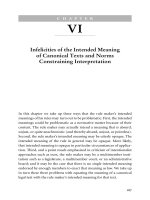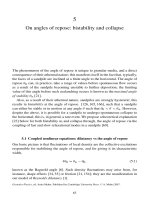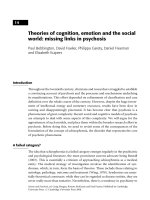Glossary of structural geology and tectonics
Bạn đang xem bản rút gọn của tài liệu. Xem và tải ngay bản đầy đủ của tài liệu tại đây (5.72 MB, 203 trang )
Glossary of
Structural Geology
and
Tectonics
P.S. Saklani
SATISH SERIAL PUBLISHING HOUSE
Glossary of
Structural Geology
and
Tectonics
"This page is Intentionally Left Blank"
Glossary of
Structural Geology
and
Tectonics
Edited by:
P.S. Saklani
Department of Geology
University of Delhi (Retired)
and
Emeritus Professor
Netaji Subhas Institute of Technology
Dwarka, New Delhi - 110075
2008
le
l
SATISH SERIAL PUBLISHING HOUSE
403, Express Tower, Commercial Complex, Azadpur, Delhi-110033 (India)
Phone: 011-27672469, 27672852, Fax: 91-11-27672046
E-mail:@yahoo.com
Websi!e : www.satishserial.com
Published by :
SATISH SERIAL PUBLISHING HOUSE
403, Express Tower, Commercial Complex, Azadpur,
Delhi-110033 (India)
Phone: 011-27672852, Fax: 91-11-27672046
E-mail: @yahoo.com
Website : www.satishserial.com
First Published 2008
ISBN :
978-81-89304-44-7
ISBN: 81-89304-44-5
©2008 All rights reserved. This book, or any parts thereof
may not be reproduced in any form without the written
permission of the publisher and the consent of the authors.
Printed at
SALASAR IMAGING SYSTEMS, DELHI-35
PREFACE
I have been teaching Structural Geology and Tectonics for the past
four decades and during this period, I always felt a need for a glossary
or definitional dictionary devoted to this branch. I th~refor~, made
an attempt in this direction.
The editor for while doing the groundwork of the book made use of
Glossary of Geology edited by R. Bates & J. Jackson (Am. Geo!. Inst.,
1980); Glossary of Geology in Hindi edited by myself (CSTT Govt. of
India 1996); Introduction to the structure of the earth by E. Spencer;
Tectonic Geology by myself (2006); Geology: an Introduction by
myself (2004).
This glossary is based on the works of many structural geologists
and I have always tried to acknowledge their works. I have attempted
to explain many terms with the help of illustrations citing many
Indian examples wherever possible.
During the preparation of this book. I held discussions with my
students namely, Or. Satendra (New Delhi); Or. D.C Nainwal
(Gopeshwar); Dr. S.C Bhatt, Dr. B.C Joshi, Or. V.K. Singh and Prof.
S.P. Singh (Bundelkhand University, Jhansi); Prof. A.K. Shandilya
(Sagar University); Prof. CS. Dubey, K.N. Kandwal (Delhi University);
S. Shekhar (Ground Water Board, New Delhi); Dr. A.C Pandey (BIT
Mesra - Ranchi) and many figures have been taken in this book from
their research works.
The book is being published under the aegis of the Geoscience
Foundation, India and hopefully it would be llseful to students,
research scholars and teachers connected with this branch of geology.
P.S. Saklani
Secretary General
Geoscience Foundation, India.
"This page is Intentionally Left Blank"
CONTENTS
A
A Axis ..................................................... Axial symmetry
1-9
B
Back-limb thrust fault ..................................... Bysmalith
11-15
C
Cactolith ................................................ Crystaishucture
17-28
D
Decollement ............................................................ Duplex
29-39
E
Elastic deformation ......................... Extension fracture
41-45
F
Fabric ............................................ Front-limb thrust fault
47-57
G
Geodynamics ........................ Gutenberg discontinuity
59-65
H
Hangingwall Ramps and Flats ........................... Horst
67-78
I
Idiogeosyncline ................................. Isostatic anomaly
79-82
J
Joint ............................................................... Jura-type fold
83
viii
K
Keystone fault ......................................................... Kraton
85-86
L
Lagfault ............................................................ L-tectonite
87-92
M
Macro-axis ........................................ Mylonitic structure
93-97
N
Nappe .......................................................................... Nose
99-102
o
Obduction .......................................... Overthrustnappe
103-107
p
Palinspastic map ......... ..................... Pyrenean orogeny
109-120
Q
Quaquaversal .................................. Quaquaversal fold
121
R
Radial fault ...................................................... Rule of V's
123-132
S
Saddle ............................................................ Sythetic fault
133-146
T
Tacnian orogeny .......................................... True folding
147-152
U
Uinta structure ......................... Uttarkashi Earthquake
153-157
V
Variscanorogeny .................................................... Vortex
159
W
Wall ................................................................ Wrench fault
161
ix
y
Young [srruc geol]................................................................
163
Z
Zigzag fold .................................................................. Zone
165
Refrrences ....................................................................... .
167-175
Author Index ................................................................. .
177-179
Subject Index ................................................................. .
181-191
"This page is Intentionally Left Blank"
A Axis It is an othogonal reference axis, It describes the
geometry of a fabric possessing monoclinic symmetry.
In a monoclinic symmetry, it represents progressive
simple shear and as such the a axis (= x- axis) again
lies in the unique plane of symmetry but parallel to
the movement plane. It is commonly referred to as
the direction of tectonic transport. In a progressive
simple shear the a axis is the direction of shear. Some
workers refer the a, band c axes as x,y and z. (Fig. 1)
a
c
Fig. 1. Tectonite and its a, band c axes
2
Glossary of Structural Geology and Tectonics
Anticlinorium It is anticlinorium in which the axial surfaces
of the subsidiary folds converge upwards. While in a
synclinorium the axial surfaces of the subsidiary folds
converge downwards. (Fig. 2).
anticlinorium
synclinorium
~
Fig. 2. Anticlinorium : Synclinorium
Acadian orogeny A Middle Palaeozoic deformation,
especially in the northern Appalachians. It is named
after Acadia, (old French name for the Canadian
Maritime Provinces). It has been dated radiometrically
as between 330 and 360 m.y. ago.
Accordant fold It is a fold having similar orientation.
Accordian fold: angular fold. It is an old term, (Fig. 3)
sometimes used for kink fold, zigzag fold; chevron fold.
Fig. 3. Accordian Fold
3
P.S. Saklani
Accreting plate boundary A boundary between the two
moving apart plates, with formation of new oceanictype lithosphere (Dennis & Atwater, 1974, Dennis (ed),
1967).
Accretion A sedimentary process by which an inorganic
body increases in size by the external addition of fresh
particles with deposition of eolian sand on a
continuous sand surface.
Acrobatholithic A little used term. It is a mineral deposit
occurring in or near an exposed batholith d.ome; also,
due to batholith erosion (Emmons, 1933).
Acitve fault A fault which is characterized by recurrent
movement due to the periodic displacements or seismic
activity.
A direction
= a axis.
Advection Lateral mass movements of mantle material.
Compare : convection.
Aerial mapping Maps prepared by aerial photographs for
interpretation of geology.
Affine A homegeneous deformation, i.e. straight lines
remain straight after deformation (Fig.4).
::0.
......
/'
.........
.........
"-
/
1
\
I
\
i
I
,
\
I'
'-....
/
./
_/
"
~
~
/'
"
/
I
\--
~
-'I.
J
" ........ -
/
./
.--'
<:
Fig. 4. Diagrammatic example of a circle changed into an ellipse by
movement along glide planes. (After Billings, 2000).
4
Glossary of Structural Geology and Tectonics
Aftershock An earthquake ocurring after a large
earthquake (main shock) near the focus of the larger
earthquake. Aftershocks, decrease in frequency and
magnitude with time.
Airy hypothesis This mechanism of isostasy, was proposed
by George Bedell Airy, indicating an equilibrium of
crustal blocks of the same density but of different size.
Akmolith : acmolith An igneous intrusion occurring along
a zone of decollement, with or without extension.
Allegheny orogeny An orogeny characterized by deformed
rocks of the Valley and Ridge province of the adjacent
Allegheny Plateau of the centeral and southern
Appalachians.
Allochthon : allochthone A mass of rock which is not in its
place of origin due to tectonic movement, as is also
observed in a thurst sheet or nappe.
Allochthone : allochthon.
Allochthonous : allogenic Transported elsewhere than its
present place; of foreign origin, transported on a lowangle thrust fault. The term was first used by
Naumann (1858) for rocks of distant origin. (Fig. 5).
Fig. 5. The structure of the western Alps showing underthrusting of
the geosynclinal sediments by basement blocks. In Hills, 1973.
K, crystalline basement; W, crystalline wedge; /, autochthonous nappes; Il,
parautochthonous nappes; Ill, exotic nappes; IV, median massif; ma, granitic
magma. (After Kober)
P.S. Saklani
5
Alpides : Alpine-Himalayan belt A name used by Suess
for the great orogenic belt or system of young folded
mountains, including the Alps, extending east ward
from Spain into southern Asia.
Alpine The structural features resembling in complexity
with those of the European Alps, regardless of the
age or location of the mountains.
Alpine orogeny A young orogenic event of European and
Asian region, by which the rocks of the Alps (Alpides)
were strongly deformed. Many geologists restrict this
into the Tertiary i.e., during the Miocene or Pliocene.
(Fig. 6)
Fig. 6. The nappe structures of the Western Alps, showing the
Traineau ecraseur pushing against the Alpine edifice and over-riding
the foreland of Europe (Fo). (After Agrand, in Hills, 1973)
Alpinotype tectonics The tectonic features of orogenic belts.
Their internal parts are characterized by deeps-seated
fclding and plutonism, The external parts show lateral
thrusting, associated with the nappes / thrust sheets.
(Fig. 6).
Amplitude [fold] A symmetrical fold system having an
amplitude or a wave form, i.e. it has half the
orthogonal distance between the antiformal and
synformal enveloping surfaces.
Angular fold A kink fold which has a less angular hinge.
6
Glossary of Structural Geology and Tectonics
Angular unconformity
angular discordance;
clinonconformity; structural unconformity; orogenic
unconformity. An unconformihj between the two groups
of rocks. The older, underlying rocks dip at a diffferent
angle(usually steeper) than the younger overlying
strata resting upon the eroded surface of tilted or folded
older rocks. (Fig. 7)
Fig. 7. Angular unconformity
Annealing recrystallization The formation of new grains
in a rock formed in soild-state deformation, while the
temperature is still high. It is a recovery process,
starting 'with nucleation giving rise to grain growth.
Apparent dip: false dip The angle formed by a bedding or
fault plane, with the horizontal strata, measured in
random, vertical or perpendicular sections. The angle
is always less then the true dip.
Appressed fold A fold whose limbs are almost parallel.
Aseismic ridge This ridge is a fragment of continental crust;
it is so named to distinguish it from the seismically
active mid-oceanic ridge.
Attitude The position of a structural surface relative to the
horizontal ones. It has strike and dip measurements.
"
7
P.S. Saklani
Augen : augen structures These structures consist of large
lenticular mineral grains or mineral aggregates having
the shape of an eye in cross sections, in contrast to the
shapes of other minerals in the rock. (Eyed structure;
phacoidal structure). In metamorphic rocks, such as
gneisses and schists minerals like feldspar, quartz, or
garnet are squeezed into elliptical or lensoi'del
structures resembling eyes (augen), These are
commonly enveloped by layers of mica or chlorite.
Austrain orogeny Stille (1930 - 1940) described this
Phanerozoic shortlived orogeny in Europe.
Autochthon : authochthone A rock unit which remained
at its site of origin, rooted to its basement.
Authochonous rocks can be deformed.
Autochthonous : authigenic The term was used by
Naumann (1858) for rock units which remained at
the site of their formation.
Autogeosyncline : residual geosyncline A parageosync1ine
without an adjoining uplifted area, containing mostly
carbonates (Kay, 1947).
Axial plane A planar surface parallel to axis of a fold
(Fig. 8).
Crestal plone
-Ai~~ Crest
~AxIs
Axial plane
Fig.B.
8
Glossary of Structural Geology and Tectonics
Axial plane cleavage: Which is parallel to the axial planes
of folds. It can diverge on flanks of folds (fan cleavage).
Sometimes it is parallel to the regional fold axes. (slaty
cleavage). (Fig. 9).
NE
1
m
A
NE
4'
•
~ 0
d
Q
-!:...42.
;.134"
2 _
m _ _ _~111'
5
\
.
. . . .....:..-~'
. . 120'
_
20'HHE 15S' ~
aO'SE
g·HW
HONE
17·SW
B
Fig. 9. (A+B). The beds and axes in recumbent F3 folds with fan
cleavage - 53 in the Bhelunta slate-limestone within the Dunda
Window, 4.8 km south of Dunda, Utlarakhand Area.
9
P.S. Sakiani
Axial symmetry: spheroidal symmetry In rock fabric
having a unique axis of symmetry, and infinite number
of mirror planes passing through that axis. (Fig. 10).
A
c
t
I
Fig. 10. Axial symmetry of fabric in diagrammatic form
A. Vertical section of an igneous stock or cupola showing linear
structure of hornblende prisms. Insets: local fabric diagrams of
hornblende axes. Polar axial symmetry.
B. Vertical section of lacustrine sedimentary basin showing
direction of settling and ultimate orientation of flaky particles.
Insets: local fabric diagrams of poles to clay flakes. Polar axial
symmetry.
C. Central axial symmetry as expressed by the fabric of gypsum
tablets in a rod produced by kneading (left) and of rutile needles
in a disc obtained by 'spreading' of a ball of clay (right). Insets:
integrated fabric diagrams (in Hills, 1973).
DDD
"This page is Intentionally Left Blank"
_ _----aBack-limb thrust fault: backlimb thrust fault A fault
developed on the gently dipping "back limb" of an
asymmetric anticline, in which the direction at the
limb shows steeper angles (Douglas, 1950).
Back thrusting A thrust fault in an orogenic belt, showing
the direction of displacement towards its interior, or
contrary to the tectonic transport direction.
Baikalian orogeny An orogeny that occurred during the
Precambrian-Cambrian transition, reported from the
lower Riphean rocks. It is named after Lake Baikal in
Russia.
Bald-headed anticline An eroded anticline whose crest is
occupied by unconformable beds. A comon term used
in petroleum geology.
Basement fold A compressional structure formed within a
continent and affecting the entire thickness of the
continental crust.
B axis It is one of the three orthogonal axes, (a, b, and c)
and is used to describe the fabric geometry. This axis
is at right angles to the unique plane of symmetry. In
a deformation plan it has monoclinic symmetry. In
simple shear the b axis lies in the shear plane at right
angles to the direction of shear (See Fig. 1).
12
Glossary of Structural Geology and Tectonics
Bedding-plane cleavage : bedding cleavage; parallel
cleavage It is parallel to the bedding plane.
Bedding -plane fault bedding fault.
Bedding -plane slip : flexural slip thrust The slip occurs
of the sedimentary rocks along bedding plane during
flexure folding (Fig. 11).
In competent bed
-~-.:"-::
Competent bed
--:::,.-:::-::::.-"::--.;.......
--~~~~=====~=~~--
--;:::=-=~.::::--
Fig. 11. Bedding plane slip thrust
Bedding thrust : bedding glide.
Benioff seismic zone A plane beneath the trenches of the
Pacific belt, inclined toward the continents at an angle
of about 45°, along earthquake foci. It is also called as
the Benioff fault zone. The litho spheric plates sink into
the mantle and cause earthquakes along this zone.
Beta diagram Plots of linear structures on a stereographic
or equalarea net. Usually called as f3 diagram.
13
P.S. Saklani
Block faulting A type of normal faulting in which the
rockmass is divided into faulted blocks of different
dimensions. (Fig. 12).
Fig. 12.
Boudinage : sausage structure This structure is developed
in sedimentary and metamorphic rocks, in which a
competent layer or bed between the less competent
layers due to extension gets broken at regular intervals
into boudins or sausages, which are elongated and
parallel to the fold axes. (Fig. 13).
Baudin
---~- Boudin line
Boudins
Fig. 13.
14
Glossary of Structural Geology and Tectonics
Box fold A fold style whose sides are rectangular (Fig. 14).
Fig. 14.
Brachygeosyndine An oval shaped depression formed
during the later stages of geosynclinal deformation;
secondary geosyncline (Peyve & Sinitzyn, 1950).
Brached anticline An eroded, crest of an anticline flanked
by inward-facing erosional scarps.
Break thrust An overthrust formed due to deformation and
fracturing of an anticline. (Fig. 15).
T
Fig. IS









